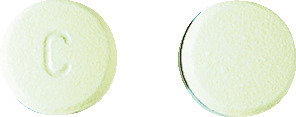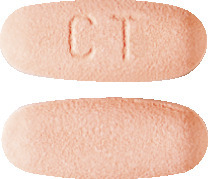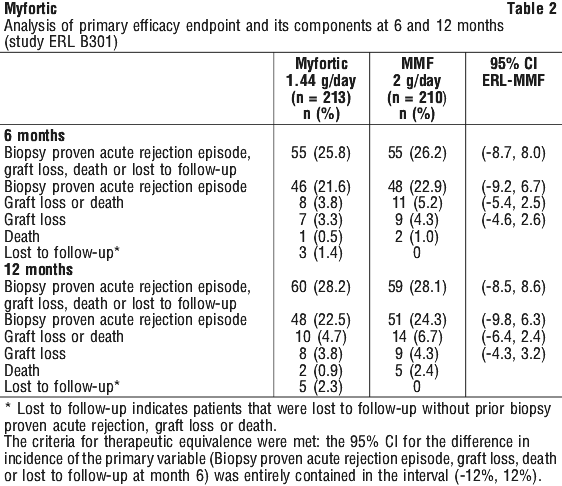SUMMARY CMI
MYFORTIC®
Consumer Medicine Information (CMI) summary
The full CMI on the next page has more details. If you are worried about using this medicine, speak to your doctor or pharmacist.
1. Why am I using MYFORTIC?
MYFORTIC contains the active ingredient mycophenolate sodium. MYFORTIC is used in adult patients: 1) to prevent the body from rejecting a transplanted kidney; 2) It is also used to treat inflammatory kidney disease associated with chronic autoimmune disorder known as systemic lupus erythematosis (also called lupus or SLE). MYFORTIC is used in combination with other medicines. For more information, see Section 1. Why am I using MYFORTIC? in the full CMI.
2. What should I know before I use MYFORTIC?
Do not use if you have ever had an allergic reaction to mycophenolate sodium or any of the ingredients listed at the end of the CMI. Talk to your doctor if you have any other medical conditions, take any other medicines, or are pregnant or plan to become pregnant or are breastfeeding. For more information, see Section 2. What should I know before I use MYFORTIC? in the full CMI.
3. What if I am taking other medicines?
Some medicines may interfere with MYFORTIC and affect how it works. A list of these medicines is in Section 3. What if I am taking other medicines? in the full CMI.
4. How do I use MYFORTIC?
- The recommended dose is 720 mg twice daily (1440 mg / day). Your healthcare provider may prescribe a different dose that is right for you; particularly for the initial treatment of inflammatory kidney disease associated with lupus.
- Use MYFORTIC exactly as prescribed.
More instructions can be found in Section 4. How do I use MYFORTIC? in the full CMI.
5. What should I know while using MYFORTIC?
| Things you should do |
|
| Things you should not do |
|
| Driving or using machines |
|
| Drinking alcohol |
|
| Looking after your medicine |
|
For more information, see Section 5. What should I know while using MYFORTIC? in the full CMI.
6. Are there any side effects?
Common side effects include constipation, diarrhea, indigestion, nausea, vomiting, muscle pain, dizziness, fever. Serious side effects include: vision changes, rash, enlarged glands, new lump or mole on your skin, severe high blood pressure. For the full list of sides effects and for more information, including what to do if you have any side effects, see Section 6. Are there any side effects? in the full CMI.
FULL CMI
MYFORTIC® (my-for-tic)
Active ingredient(s): mycophenolate sodium
Consumer Medicine Information (CMI)
This leaflet provides important information about using MYFORTIC. You should also speak to your doctor or pharmacist if you would like further information or if you have any concerns or questions about using MYFORTIC.
Where to find information in this leaflet:
1. Why am I using MYFORTIC?
2. What should I know before I use MYFORTIC?
3. What if I am taking other medicines?
4. How do I use MYFORTIC?
5. What should I know while using MYFORTIC?
6. Are there any side effects?
7. Product details
1. Why am I using MYFORTIC?
MYFORTIC contains the active mycophenolate sodium.
MYFORTIC belongs to a group of medicines called immunosuppressives. These medicines work by stopping your immune system from rejecting the transplanted organ.
MYFORTIC is used for people who have had a kidney transplant, to prevent the body from rejecting the new kidney. It is also used for people who have inflammatory kidney disease associated with a chronic autoimmune disorder known as systemic lupus erythematosis (also called lupus or SLE). MYFORTIC is used in combination with other medicines.
2. What should I know before I use MYFORTIC?
Warnings
Do not use MYFORTIC if:
- you are allergic to mycophenolate sodium (the active ingredient in MYFORTIC), or any of the ingredients listed at the end of this leaflet.
- you are pregnant, think you may be pregnant, or intend to become pregnant.
- you are not using effective contraception.
- you are breastfeeding.
- the package is torn or shows signs of tampering
- the expiry date printed on the pack has passed
Always check the ingredients to make sure you can use this medicine.
Check with your doctor if you:
have or have had:
- sunspots or skin cancers,
- low neutrophil (a type of white blood cell) blood count.
- serious problems with your stomach or bowel, such as ulcers or bleeding.
- Lesch-Nyhan or Kelley-Seegmiller syndrome (a rare hereditary disorder that affects males only and is caused by a deficiency of a specific enzyme)
Your doctor may not want you to take MYFORTIC or may want to take precautions if you have any of the above conditions.
- plan to have vaccinations.
- are lactose intolerant as MYFORTIC tablets contain lactose.
- are allergic to any other medicines, foods, dyes or preservatives.
Pregnancy and breastfeeding
Check with your doctor if you are pregnant or intend to become pregnant. You must not take MYFORTIC if you are pregnant. If you are a woman who could become pregnant, you must provide a negative pregnancy test before starting treatment and must follow the contraceptive advice given to you by your doctor. Your doctor may request more than one test to ensure you are not pregnant before starting MYFORTIC.
If you are planning to have a child, your doctor will talk to you about the risks and alternative treatments you can take to prevent rejection of your transplant organ.
- Talk to your doctor if you are breastfeeding or intend to breastfeed. You must not breastfeed during treatment with MYFORTIC. This is because small amounts of the medicine can pass into the mother's milk.
During treatment, you may be at risk of developing certain side effects. It is important you understand these risks and how to monitor for them. See additional information under Section 6. Are there any side effects?
3. What if I am taking other medicines?
Tell your doctor or pharmacist if you are taking any other medicines, including any medicines, vitamins or supplements that you buy without a prescription from your pharmacy, supermarket or health food shop.
Some medicines may interfere with MYFORTIC.
These medicines include:
- antacids that contain magnesium or aluminium hydroxide
- azathioprine, tacrolimus, or any other immunosuppressive medicine
- certain live vaccines
- cholestyramine (used to treat high blood cholesterol levels)
- aciclovir or ganciclovir (used to treat viral infections)
- oral contraceptives. These may not work as well while you are taking MYFORTIC and you could become pregnant. Talk to your doctor about other birth control methods that can be used while you are taking MYFORTIC.
You may need to take different amounts of your medicines or you may need to take different medicines.
Your doctor and pharmacist have more information on medicines to be careful with or avoid while taking MYFORTIC.
Check with your doctor or pharmacist if you are not sure about what medicines, vitamins or supplements you are taking and if these affect MYFORTIC.
4. How do I use MYFORTIC?
How much to take
- The usual dose is 1,440 mg, taken as 720 mg twice a day. Your doctor may have prescribed a different dose, particularly for the initial treatment of inflammatory kidney disease.
- Take MYFORTIC exactly as your doctor has prescribed.
This will ensure that this medicine will work properly and prevent any unwanted side effects.
Follow the instructions provided and use MYFORTIC until your doctor tells you to stop.
When to take MYFORTIC
- MYFORTIC should be taken twice a day, 12 hours apart, if possible. Taking your doses 12 hours apart will have the best effect.
- If you have had a renal transplant, your first dose will usually be given within 48 hours after your transplant.
How to take MYFORTIC
- Remove the tablets from the foil blister pack when you are ready to take them.
- Swallow the tablets whole with a full glass of water.
- Do not chew or crush the tablets.
- Do not take any tablets that are broken or split.
- You may take MYFORTIC with or without food.
It does not matter if you take MYFORTIC after food or on an empty stomach, if you take it the same way each day. - If you take it with food, always take it with food.
- If you take it without food, always take it without food.
If you forget to use MYFORTIC
MYFORTIC should be used regularly at the same time each day. This will also help you remember when to take it.
If it is almost time for your next dose, skip the dose you missed and take your next dose when you are meant to. Otherwise, take it as soon as you remember, and then go back to taking it as you would normally.
Do not take a double dose to make up for the dose you missed. This may increase your change of getting an unwanted side effect.
If you miss more than one dose, contact your doctor as soon as possible.
If you use too much MYFORTIC
If you think that you have used too much MYFORTIC, you may need urgent medical attention.
You should immediately:
- phone the Poisons Information Centre
(by calling 13 11 26), or - contact your doctor, or
- go to the Emergency Department at your nearest hospital.
You should do this even if there are no signs of discomfort or poisoning.
5. What should I know while using MYFORTIC?
Things you should do
- Make sure to keep all your doctor's appointments and have any tests done that are ordered by your doctor.
- If you are about to be started on any new medicine, remind your doctor, dentist or pharmacist you visit that you are using MYFORTIC.
- If you are a woman of child-bearing age, you must use effective contraception measures before you take MYFORTIC, while you are taking MYFORTIC, and for 6 weeks after you stop taking MYFORTIC. If you are taking oral contraceptives, you must also use another form of birth control.
- If you are a sexually active man, you should use condoms during treatment with MYFORTIC and for 13 weeks after stopping treatment even if you have had a vasectomy. Your partner should also use effective contraception during your treatment and for 13 weeks after you have stopped MYFORTIC.
- Take special care during exposure to sunlight. If you go out in the sun, limit your exposure to sunlight and UV light by wearing a hat, protective clothing and sunscreen with a high protection factor. This will help to prevent the development of skin cancer.
- Take special care of your teeth and gums. People taking immunosuppressant medicines are at a greater risk of getting infections. Taking good care of your teeth and gums will help to prevent dental and mouth infections
Call your doctor straight away if you:
- Have COVID-19, increased severity of COVID-19 may occur with MYFORTIC.
- are a woman or child-bearing age, taking effective contraception measures and you think your contraception may not have been effective or if you have forgotten to take your contraceptive pill
- are a sexually active man, and your partner becomes pregnant while you are taking MYFORTIC.
- develop lumps anywhere in your body, or develop any moles, or you notice changes in existing moles. This may be an early sign of a cancer. Immunosuppressant medicines, including MYFORTIC, may increase the risk of developing certain cancers, including skin cancer and lymphoma (cancer of the lymphatic system).
Things you should not do
- Do not stop using this medicine without first checking with your doctor.
- Do not have any vaccinations without first checking with your doctor.
- Do not give MYFORTIC to anyone else even if their condition seems similar to yours.
- Do not donate blood during treatment with MYFORTIC and for at least 6 weeks after stopping treatment.
- Do not breastfeed during treatment with MYFORTIC and for 6 weeks after you have stopped taking MYFORTIC.
- Men must not donate semen during treatment with MYFORTIC and for at least 90 days after stopping treatment.
Driving or using machines
Be careful before you drive or use any machines or tools until you know how MYFORTIC affects you.
MYFORTIC is not expected to affect your ability to drive a car or operate machinery.
Looking after your medicine
- Keep your tablets in the foil blister pack until it is time to take them.
Follow the instructions in the carton on how to take care of your medicine properly.
- Store the pack in a cool dry place where the temperature stays below 30°C, do not store it:
- in the bathroom or near a sink, or
- in the car or on window sills.
Keep it where young children cannot reach it.
When to discard your medicine
If your doctor tells you to stop taking MYFORTIC, or the expiry date has passed, take it to the pharmacy for safe disposal. Do not use this medicine after the expiry date.
6. Are there any side effects?
All medicines can have side effects. If you do experience any side effects, most of them are minor and temporary. However, some side effects may need medical attention.
See the information below and, if you need to, ask your doctor or pharmacist if you have any further questions about side effects.
Less serious side effects
| Less serious side effects | What to do |
| Speak to your doctor if you have any of these less serious side effects and they worry you. |
Serious side effects
| Serious side effects | What to do |
| Call your doctor straight away, or go straight to the Emergency Department at your nearest hospital if you notice any of these serious side effects. |
Tell your doctor or pharmacist if you notice anything else that may be making you feel unwell.
Other side effects not listed here may occur in some people.
Reporting side effects
After you have received medical advice for any side effects you experience, you can report side effects to the Therapeutic Goods Administration online at www.tga.gov.au/reporting-problems. By reporting side effects, you can help provide more information on the safety of this medicine.
Always make sure you speak to your doctor or pharmacist before you decide to stop taking any of your medicines.
7. Product details
This medicine is only available with a doctor's prescription.
What MYFORTIC contains
| Active ingredient (main ingredient) | either 180 mg or 360 mg mycophenolic acid |
| Other ingredients (inactive ingredients) |
|
| Potential allergens | lactose |
Do not take this medicine if you are allergic to any of these ingredients.
What MYFORTIC looks like
MYFORTIC 180 mg tablets (AUST R 91939) are lime green, film-coated round tablets, with bevelled edges and the imprint "C" on one side.
MYFORTIC 360 mg tablets (AUST R 91940) are pale orange red film-coated ovaloid tablets with imprint 'CT' on one side.
MYFORTIC is available in packs of 120 tablets.
Who distributes MYFORTIC
MYFORTIC is supplied in Australia by:
NOVARTIS Pharmaceuticals Australia Pty Limited
ABN 18 004 244 160
54 Waterloo Road
North Ryde NSW 2113
Telephone: 1 800 671 203
Web site: www.novartis.com.au
MYFORTIC is supplied in New Zealand by:
Novartis New Zealand Limited
PO Box 99102
Newmarket
Auckland 1149
Telephone 0800 354 335
This leaflet was prepared in September 2024.
Internal Document code:
(myf060924c) based on PI (myf060924i)
Published by MIMS November 2024



 Renal transplant patients were treated with 1440 mg Myfortic daily up to one year. A similar profile was seen in the de novo and maintenance transplant population although the incidence tended to be lower in the maintenance patients.
Renal transplant patients were treated with 1440 mg Myfortic daily up to one year. A similar profile was seen in the de novo and maintenance transplant population although the incidence tended to be lower in the maintenance patients.



